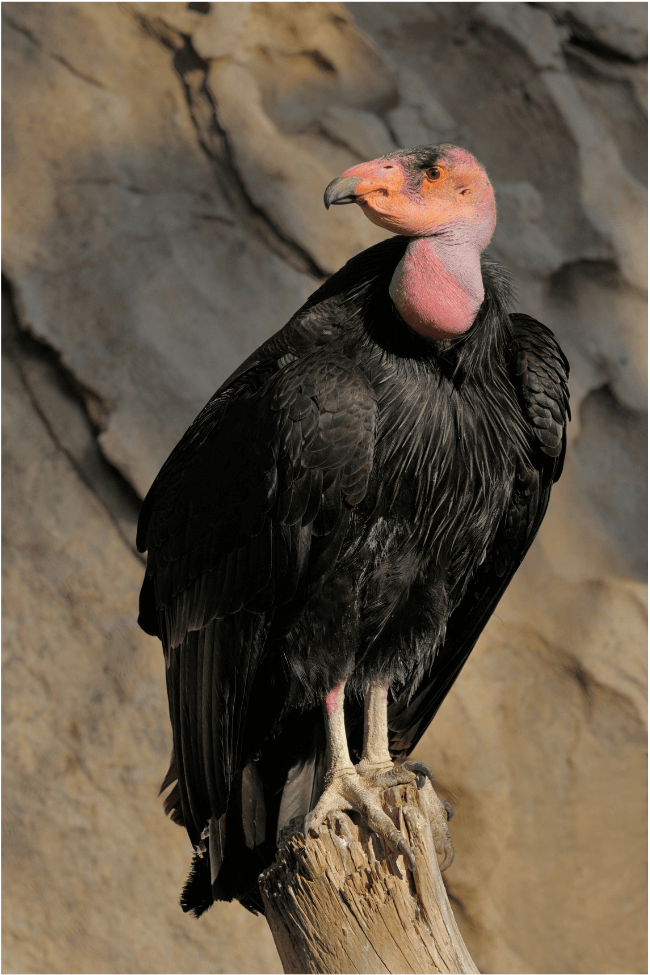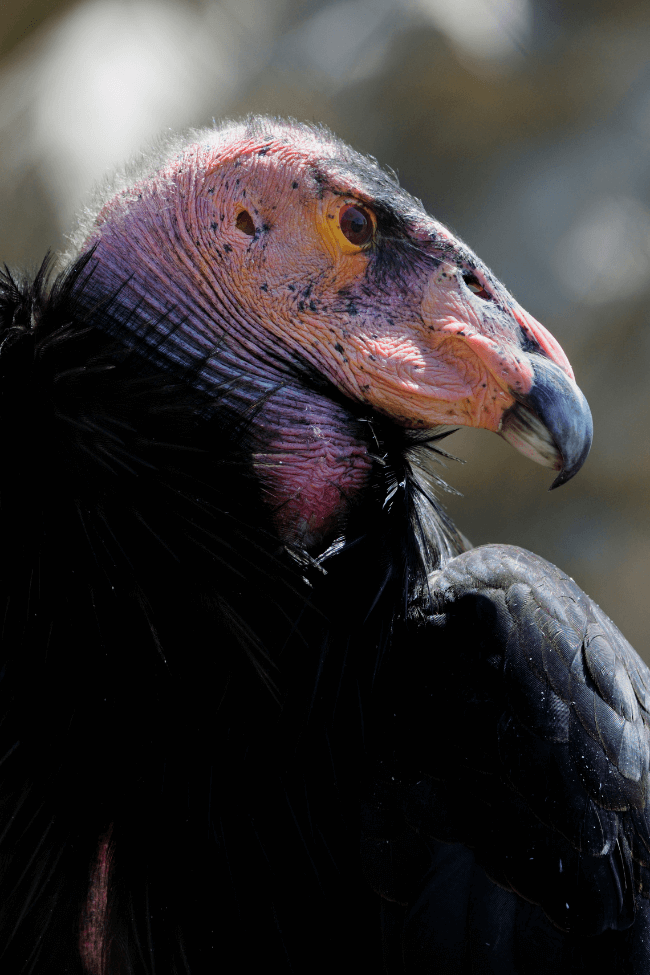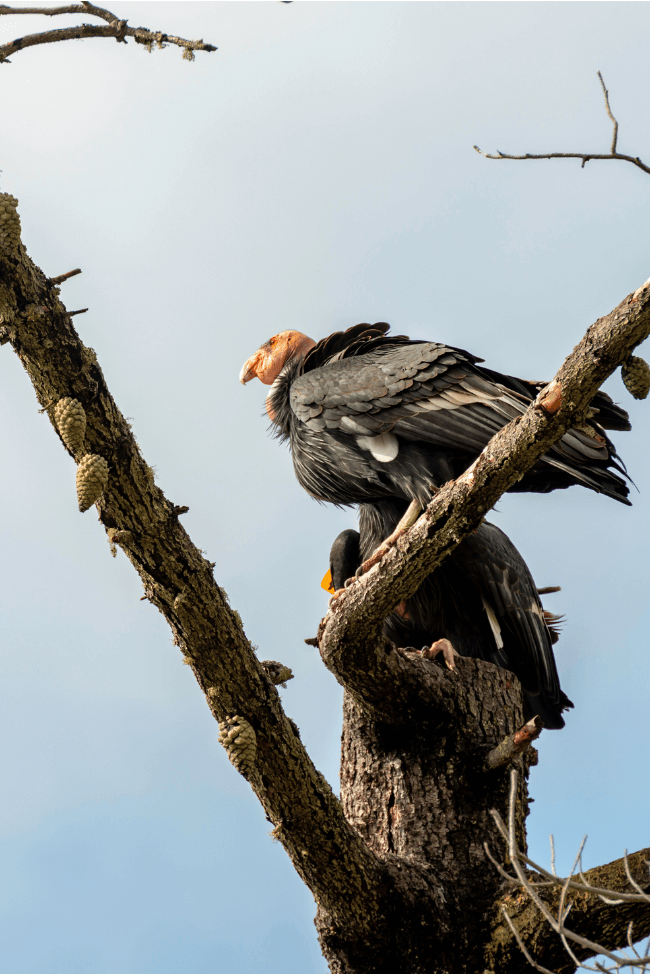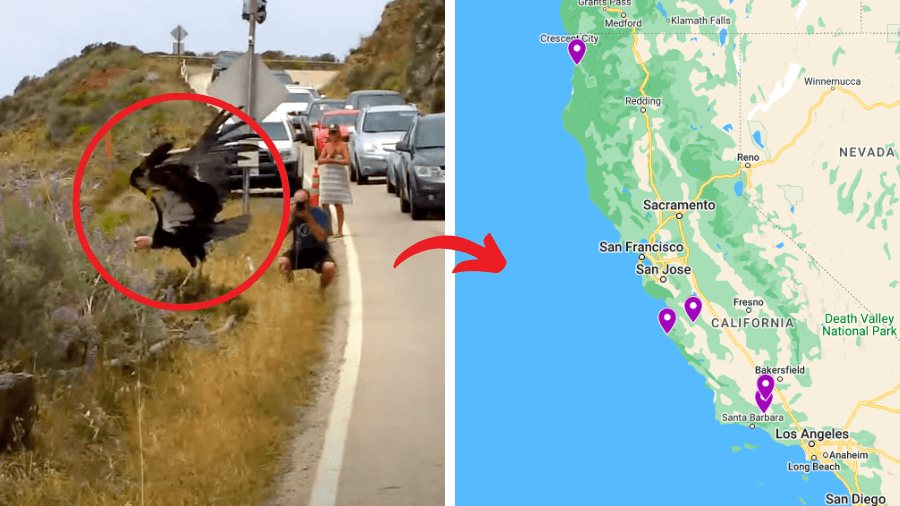California Condors are amazing birds.
They’re the largest flying birds in North America and you can recognize them by their huge wings and bald heads.
People sometimes mistake them for distant planes in the sky rather than birds!
These birds almost vanished forever, but people worked hard to save them.
Now, they’re slowly coming back in places like California.
Seeing a California Condor is a really special experience, so today we’re sharing where you have a chance of seeing them in the wild!
BUT REMEMBER.
These are still endangered birds so even in the best condor-spotting places you might not see them.

Fact File
Here’s a quick fact file about them.
- Scientific Name: Gymnogyps californianus.
- Wingspan: Their wingspan is massive, stretching up to 9.8 feet (about 3 meters)!
- Weight: They can weigh between 18 to 25 pounds (8 to 11 kilograms).
- Appearance: They have black feathers with white patches under their wings.
Their heads are bald and can change color based on their emotions! 🤯
- Diet: Condors are scavengers.
They mainly eat carrion, which is the meat of dead animals.
- Habitat: They live in rocky, forested regions, including canyons and cliffs.
- Conservation Status: They are critically endangered.
This means they were almost extinct in the wild.
- Conservation Efforts: Thanks to breeding programs, their numbers are slowly increasing.
In 1987 their worldwide population was less than 30, now there are a few hundred.
What Should I Bring With Me?
When planning to observe California Condors in the wild, it’s important to have the right equipment to enhance your experience.
Here’s a list of recommended items:
- Binoculars: A good pair of good binoculars is essential for bird watching.
Look for binoculars with strong magnification (at least 8×42 or 10×50) to see details from a distance. Here are some recommendations below.
– Best Overall -> Bushnell Engage Binoculars 8×42 Binoculars
– More Affordable -> Celestron Ultima 8×42 Binoculars
- Camera with a Zoom Lens: If you’re interested in photography, a camera with a zoom lens (200mm or higher) is ideal for capturing detailed images of condors in their natural habitat.
- Hiking Gear: Sturdy hiking boots, comfortable clothing suitable for the weather, a hat, and sunglasses.
Layering is key, as temperatures can vary throughout the day depending on where you go
- Sun Protection: Sunscreen and a hat are important, especially in open areas with little shade.
- Water and Snacks: Always carry enough water, especially in warmer weather or if you plan on hiking.
Snacks like energy bars can be helpful if you’re out for several hours.
- Backpack: A comfortable backpack to carry your equipment, water, snacks, and any extra clothing.
- Map and Compass/GPS: Especially in more remote areas, a map and compass or a GPS device can be invaluable for navigation.
Now that you’re prepared, there are a few places in California where you have a chance to see these magnificent birds and some are better than others.
Let’s go through them one by one.

Best Places in California to See California Condors
1. Bitter Creek National Wildlife Refuge, California
Bitter Creek National Wildlife Refuge is a special place in California.
It’s a safe home for California Condors.
The refuge has hills and valleys in the southern San Joaquin Valley.
It’s quiet and perfect for watching birds and you might see condors flying high or resting on cliffs.
This place helps condors survive and is great for seeing them.
Specific Viewing Locations:
The best spots for condor sightings include the higher elevation areas with clear views of the valley.
Best Times for Viewing:
Early mornings and late afternoons, particularly in the cooler months, are ideal for sightings.
Here’s a video of a Condor in Bitter Creek NWR…
2. Pinnacles National Park, California
Pinnacles National Park is great for seeing condors.
The park is known for its rock formations and caves.
It’s important for the condor recovery program and it is now one of the few condor release sites.
At the time of writing, there are 28 tagged condors in Pinnacles National Park which is amazing considering there were only about 27 worldwide in 1987.
Condors can be seen above the peaks, especially in the morning and afternoon.
Make sure to bring binoculars to get a closer look at these amazing birds.
Two spotting scopes have been placed in the Campground (on the Bench Trail near Pinnacles Visitor Center) that may help you get a closer look at these magnificent birds.
Here’s a video of a Condor at Pinnacles in the High Peaks Loop area…
Specific Viewing Locations:
The High Peaks and Condor Gulch trails are popular for condor sightings.
Best Times for Viewing:
Condors are most active in the park during late mornings and early afternoons, throughout the year.
3. Big Sur, California
Big Sur is famous for its stunning coastal views and it’s also a prime spot for California Condor sightings.
The condors can be seen along the cliffs and coast.
At the moment the central CA population is currently 90+ condors and half of those birds regularly visit Big Sur.
Watching them glide over the Pacific Ocean is an amazing experience and Big Sur’s beauty makes it perfect for birdwatching and photography.
Specific Viewing Locations:
Lookout points along Highway 1, especially near the Bixby Bridge, are prime spots for condor sightings.
Best Times for Viewing:
Late afternoon is a good time for sightings, particularly in spring and early summer.
You can also use these condor cams by Ventana Wildlife Society to see them from the comfort of your own home.
Here’s another video showing a Condor take flight in Big Sur.
4. Los Padres National Forest, California
Los Padres National Forest covers a big area with different habitats.
It’s another decent place to see California Condors and the forest has mountains and valleys where condors live.
In fact, they have the Sespe Condor Sanctuary within the Sespe Wilderness area.
Specific Viewing Locations:
Condor observation areas include the Mt. Pinos region and the Sespe Wilderness, known for higher condor activity.
Best Times for Viewing:
Early morning and late afternoon are the best times, with spring and fall being particularly good seasons for sightings.
Here’s a picture of one on a dead pine in Los Padres National Forest…

5. Redwood National & State Parks, California
Redwood National Park is known for its towering trees, but it’s also a traditional home for the California Condor.
But they’ve only recently been reintroduced to this area of California.
The park’s open spaces are good for spotting these and these birds can sometimes be seen flying among the giant redwoods.
This park offers a unique experience of seeing rare birds in a beautiful forest.
You can find more information at the link below:
Specific Viewing Locations:
The best places to spot condors are the open spaces and meadows within the park, where they can be seen flying overhead.
Best Times for Viewing:
Condors are most active during the warmer parts of the day here, particularly in the late morning and early afternoon.
Best Times To See Condors In California
In California, the best times to see California Condors can vary slightly depending on the specific region.
Here are some general guidelines:
Spring (March to May):
This is an excellent time in California for condor sightings.
Condors are quite active during this season, often seen engaging in nesting activities.
Summer (June to August):
Early mornings and late evenings are the best times to spot condors in the summer, as the midday heat can make them less active.
Coastal areas like Big Sur can be particularly good during this time, as the condors might be more visible along the coast.
Fall (September to November):
As the temperatures begin to cool, condors often become more active throughout the day.
This season can be great for viewing, especially in areas like Pinnacles National Park and Los Padres National Forest.
Winter (December to February):
While condors are present year-round in California, winter sightings can be more challenging due to shorter days and potentially inclement weather.
However, condors do not migrate, so they are still in the area, and patient observers might be rewarded.
Remember, these birds are still rare and sightings are never guaranteed.
Visiting well-known condor habitats, using binoculars or scopes, and possibly joining guided tours can increase your chances of seeing these majestic birds.
For the most current sighting information, check with local national parks, wildlife refuges, or condor conservation groups.
Outside California
Other places outside of California where you can see the California Condor include the following:
1. Arizona
The Grand Canyon National Park and the Vermilion Cliffs National Monument are notable for California Condor sightings.
The birds were reintroduced into northern Arizona in the 1990s and have since established a significant presence in the region.
The South Rim of the Grand Canyon offers some pretty good opportunities for sightings.
2. Utah
The condors have been known to range into southern Utah, particularly around Zion National Park and the Kolob Reservoir area.
Their presence in Utah is part of the birds’ natural range expansion from the Arizona reintroduction sites.
3. Baja California, Mexico:
There is a population of California Condors in Baja California, particularly in the Sierra de San Pedro Mártir National Park.
This area is part of a reintroduction program aimed at expanding the condor’s range and increasing the overall population.

